Up here in much of the Northern Hemisphere, spring is well and truly underway, and, in some places, summer is even creeping up on us and taking over.
This means outdoor weather! Vacation! Travel! Beach life (well, not really out here in Kansas)! Sunshine, outdoors, relaxation – you know the daydream!
Even if a vacation is not on your calendar, you might enjoy relaxing outdoors at your own little castle. I have a patio in my backyard, for example, that’s perfect for outdoor relaxation and reverie in the spring, and even mildly tolerable on summer mornings. Occasionally, it’s a great place to stitch.
Stitching outside can be a lovely change. It lends to a sense of vacation, even in your own backyard. There’s something eminently relaxing about birdsong, soft breezes, even the distant noise of Life going on – lawnmowers, kids playing down the street, the barking of a dog or the laughter of neighbors. The sound of the world waking up in the morning, or the rustle of unknown wildlife moving through the woods behind you. And the smells – fresh grass, heady flowers, that honeysuckle hedge in full bloom and the occasional waft from the lilacs. Ahhhhhhh, me. So lovely!
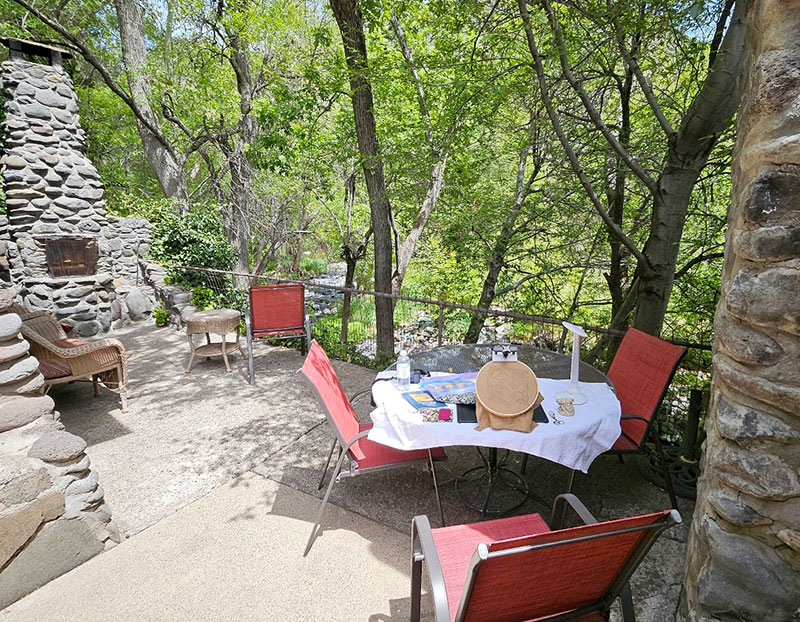
Recently, my friend Margaret went on a vacation where she was situated perfectly to enjoy some outdoor stitching time. A little correspondence during her respite reminded me how lovely it is, to stitch outdoors!
She sent photos, like the one above. How perfect a set-up! So ideal! So lovely! And in an area of the country where bugs and ticks and chiggers and woodsy creepy crawlies are not a big concern. Beautiful weather. Dry. Just … nice.
But… but! There are some precautions to take, if you’re moving your whole stitching set-up to the outdoor world. Margaret shared an anecdote – with pictorial evidence – that serves as an excellent lesson.

She uses a magnifier. It’s the kind with that small “dot” on it with extra (20x) magnification.
As the sun moved slowly along, with her magnifier in place over her fabric, she didn’t realize that the 20x little lens had caught the rays and was acting like a veritable laser, burning a hole in her fabric.
Shock horror! Fortunately, she smelled it before it developed too far. And fortunately, the resulting hole is outside the finishing area of her design.
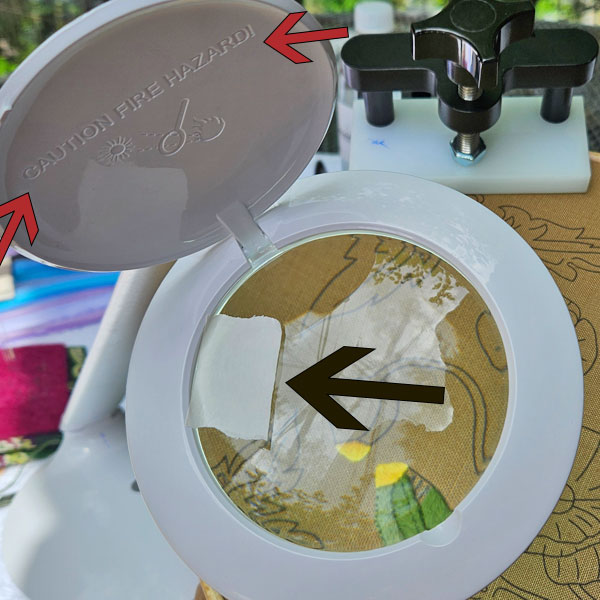
To solve the problem, she applied tape over the 20x “dot” on her magnifier’s lens.
Never underestimate that little warning imprinted on the underside of your magnifier’s cover. It really can cause a fire!
If you’re using a magnifier outdoors, consider your situation in the sun and situate yourself to avoid sun shining on the lens. Make sure your magnifier is always closed or covered if you leave your stitching for any amount of time.
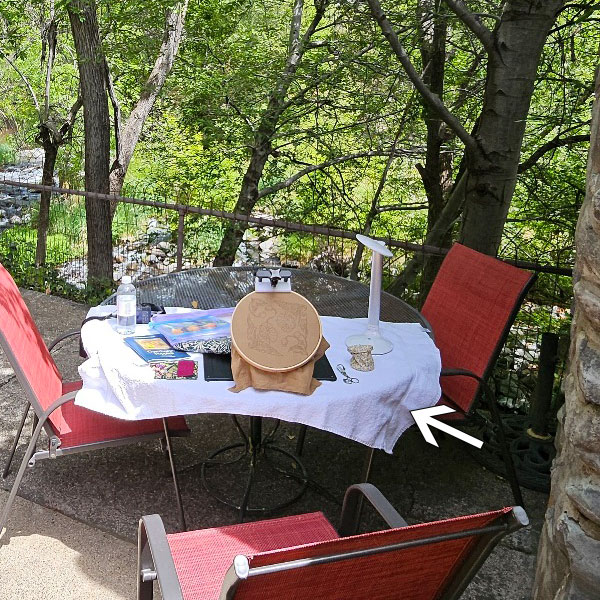
The outdoors also brings a few other concerns into play.
One of them, for me, is dirt. Kansas is a dusty old state, especially if we haven’t had any good rain. If I’m taking a lot of my stitching stuff outside, I make sure that the surface I’m using is covered with a clean cloth.
Margaret did the same. You can see that she covered the outdoor table she was using with a clean white cloth, where she put out all her supplies.
There are a few other precautions I like to take when I’m stitching outside.
Overhead Cover
I like to have something overhead when I’m stitching outside, if there’s something available. If I’m on my front porch, no problem – it’s covered.
But on my back patio, which isn’t covered, I usually have my patio umbrella up. It doesn’t necessarily cover all of me or all of my space, but I usually do my stitching underneath the patio umbrella.
Call it “PTSD” or whatever you want, but if you’ve ever had a bird poop on your head, you will understand why I prefer this!
Don’t Leave It
Don’t leave your needlework outside by itself for any long stretch of time. Bugs, dirt, that curious squirrel – they like needlework, too.
Here in Kansas, a big factor of life is the wind, and you never know when it’s going to kick up a raucous. I don’t leave anything that can shift in wind outside by itself for any extended time, whether it’s needlework, a good book, or a tea cup.
What About You?
Any tips you want to share for outdoor stitching? Feel free to join in the conversation below!


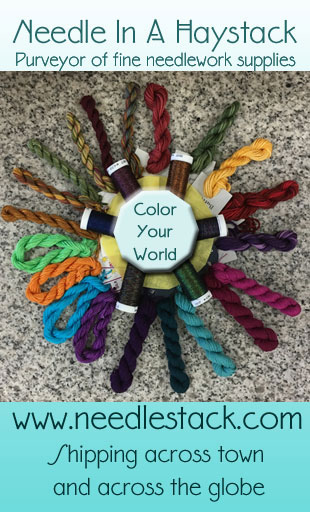



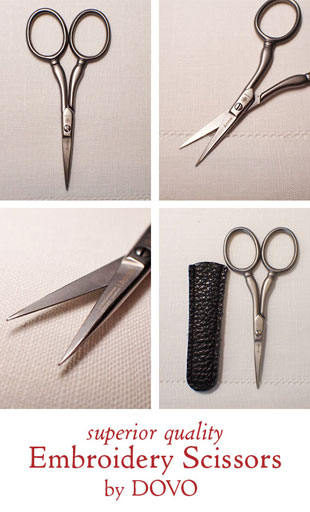
I stitch in my yard frequently. I have two small dogs who can’t be outside alone. I have coyotes, fox, hawks and even giant turkeys in the area. I have a tray table where I keep everything for my current project. I can just take the tray outside with me and have everything I need all together. I am looking for something heavy to throw over it if I have to step away.
If you are stitching at the beach (or other humid areas) remember that rust-proof needles aren’t, and grease-free sunscreen isn’t! I love stitching outside, in the shade for me. Natural light is the best!
Thanks for the tips, Mary! I’ll add another: if you are working on a wooden deck that has some open space between its slats, make sure your thimble fits snugly!! Mine fell off my finger, promptly rolled right between the boards and disappeared. Come to think of it, make sure anything small enough to disappear has a secure spot when you’re not actively using it – I like a pencil box full of stuff or a small ceramic dish that the wind won’t blow off.
Kathy
My reminder is to note that metal scissors get very hot in full sun. Maybe cover them to avoid a hot ouch moment when you need to cut threads!! I am delighted to be outside again after such a long time indoors! Minnesota had a long winter/cool windy April and I was ready to inhabit our patio. May has been a delight and I’m out there often.
Mary, I stitch as often as I can outside on our covered porch. Each morning, my husband and I watch the sun rise, while we are also watching the cardinals, blue jays, Starlings, doves and hummingbirds (we currently have 3 of these tiny birds). We drink coffee, watch birds and squirrels, and I stitch. Today, I am working on a linen with hummingbirds and flowers.
I love your website and look forward reading your wonderful advice on embroidery every day.
Thanks, Charlene
Also be very careful of using your magnifying light indoors in a sunny spot. I have a black scorch mark on the wooden arm rest of my couch from the sun hitting the magnifier when I left it unattended. Be aware & keep safe!
I live in AZ, in the desert, but one of the very, very few homes that has a grassy backyard with lots of trees, a birdbath and a small pond. The back porch is undercover and shaded all around – lots of sunshine but no direct sun until late in the afternoon on the porch. The best part is being able to listen to the birds that come visiting in the trees, the pond and bird bath. We have birdhouses around, which I painted, along with seed that we sprinkle for them. We also have those plants that hummers love. It is a beautiful setting and until the heat reaches 112-115 degrees, it’s perfect!
I was stitching a small “in hand” project on mini stretcher bars at the end of a lovely dock. Unfortunately, that same raucous wind kicked up and plucked my small project right out of my hand and threw it into the water quite a ways off. I watched as it slipped into the water and disappeared. Lesson learned – no more stitching around large, deep bodies of water.
I occasionally stitch outside during the summer and I appreciate the warning about magnifiers. I don’t usually use one, especially outside, but the thought never crossed my mind that there might be a problem. Usually, when I am working outside, it is with an easy project that I don’t need to be too fussy about and can relax with.
I have known a friend to experience a burn from the magnifying glass on her stand next to her chair in a SUNNY WINDOW INDOORS! Horrors!
Years ago when I first returned to stitching, we owned a small business. In between customers I was working on a cross stich Christmas pattern I had found in a magazine. When I went inside to help a customer I turned it upside down on the patio table to protect the red embroidery cotton. By the time I took it to the framer, the canvas had deteriorated and she had a difficult time framing it. Lesson learned.
What a great post Mary. Good heads up on the magnifier ‘dot’… uff, that could be an awful situation. But to add to other ‘outdoor’ things, here in NE Iowa (that’s the Driftless area), we have a few other bugs that frequent our outdoor living spaces that can become a concern with needlework projects done outdoors. We have stink bugs (ancient looking things) and they find their way into supplies, tote bags, project bags, and occasionally just march across the item you are working on. The other ones we have in volume is the Asian and Japanese Beetles… which also seem quite curious about all supplies and tools, plus any open top beverage you might have with you. I’m always either looking down into a water container or capping it to make sure I don’t swallow one of those guys. Until later in the summer when the wasps and bee’s get friendly. Last year it was a monster year for gnats that lasted all spring thru fall. And, also, making sure our hands are clean from putting bug repellent or sun-block on… a lot to keep on the front burner of crafting outdoors. Happy Spring everyone!
I had the very same thing happen to me. Fortunately it only burned the frame and not the fabric.
Hi Mary,
That is a good advice to be careful with the magnifier.
I am sorry, but I do not know what PTSD stands for. I am a French speaker. I understand English well, but sometimes I cannot find what those acronyms mean. Could you please tell what it stands for?
Thank you!
Post-traumatic Stress Disorder. Sorry!
Another problem can be tree sap or even just the dusty tree leaves. I have a lovely little table with chairs set up under one of my trees. Not having been an outdoorsy-type most of my life, I did not know that trees drip sap and, learned the hard way! I now have an umbrella over my sitting area also!
Stitching outdoors: When I come to the end of my thread and cut it, I don’t pull out the thread end right away. I get my spool out and cut a new length of thread THEN, when I have the needle in my hand, I pull out the old thread end and immediately put the new thread thru the eye. That way, if I drop my needle, it’s much easier to find with the thread still in the eye. I make sure to do this if I’m stitching in a waiting room, too.